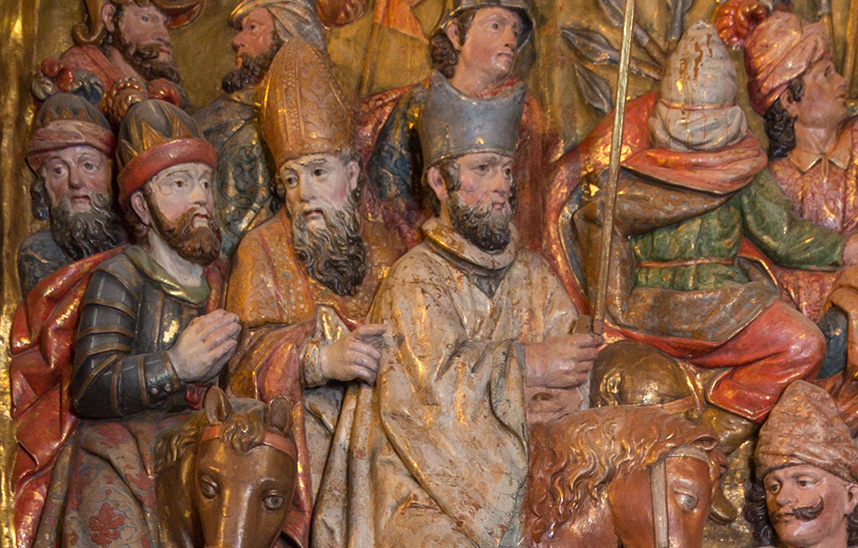A relief of the battle of Navas de Tolosa in Villatuerta

FotoFotoCalle Mayor/Detail of the relief of the battle of Navas de Tolosa, in the main altarpiece of Villatuerta, 1643 and 1645, Pedro Izquierdo and Juan Imberto III.
The reception of the historical event of the Battle of Navas (1212) in the following centuries, in addition to the handwritten and printed historiographic texts of identity transcendence, has echoes in drawings, engravings and, above all, in painting. Images, in final, with a great importance, taking into account the power of these images in a mostly illiterate society, where knowledge and thought were transmitted mainly through oral and plastic means. The literary support for most of the representations is found in the texts of Archbishop Rodrigo Ximénez de Rada, some medieval chronicles, the Annals of Navarre by Father Moret and the General History of Spain by Modesto Lafuente.
If we had to synthesize, we would say that, in general, there are three great iconographic models. The first, which turns the battle into an icon of providentialism, with the preponderance of King Spanish and Archbishop Ximénez de Rada, and incorporates the miracle of the cross in the sky. The second must be related to the ideals of 19th century history painting, with enormous compositions dedicated to the glorious and outstanding episodes of the past, carried out with large doses of reality and supposed veracity. Finally, the third, more linked to Navarre and the epic of Sancho VII the Strong, we find it from the eighteenth century in works related to the Comunidad Foral.

Relief of the battle of Navas de Tolosa, in the main altarpiece of Villatuerta, 1643 and 1645, Pedro Izquierdo and Juan Imberto III. Photo Main Street
Relief in its historical and iconographic context
Corresponding to the first case, we know of a small cycle in the monastery of Huerta, a work by the Genovese painter Bartolomé Matarana in 1580, which Ibáñez Martínez has studied. Also belonging to the same option is an enormous painting of the battle executed by Jerónimo and Pedro Ruiz de Camargo, in 1594, in Las Huelgas de Burgos. In both cases, the miracle of the cross in the air is not present, as it will be in the following cases. The portentous fact of the appearance of a resplendent cross of various colors at the beginning of the combat, which forced the Christians and terrified the Almohads, had great acceptance in painting since the 16th century, following medieval texts, such as the Chronicle of twenty kings, made between 1270 and 1289. Later, some accounts, such as that of Argote de Molina, in the second half of the 16th century, and other apologists of the Holy Cross insisted on the same. The fundamental fact that favored the representations with the miraculous appearance of the cross was the official document of the feast of the Triumph of the Holy Cross, instituted in 1573 to be celebrated on July 16 in Spain and the New World, by decision of Gregory XIII, commemorating the battle. The examples are numerous, highlighting the Araciel chapel in Alfaro or the painting by Ramón Bayeu for the main chapel of the church of the Exaltation of the Holy Cross in Zaragoza (1785).
The relief of Villatuerta sample only shows the triumphant parade of the battle, with a great protagonism of Domingo Pascual, canon from Toledo, bearer of the cross-script, the archbishop Ximénez de Rada and two kings. The troops march, without major problem, while the enemies lie on the ground defeated or retreat before the advance of the Christian troops led by Don Rodrigo and two kings, all on horseback. The presence of the prebendary of Toledo already appears in the aforementioned representations of the Cistercian monasteries of Huerta and Las Huelgas. The great relief is found in the main altarpiece, which was commissioned by Bishop Juan Queipo de Llano in 1640 and carried out in the following years, between 1643 and 1645, by Pedro Izquierdo in the architectural work and Juan Imberto III in the sculptural work itself, with the condition that it be done with the model of the Franciscan monastery of Estella, a work that has now disappeared. Its polychromy, with exquisite gilded and stewed details, was carried out by Miguel de Ibiricu and Juan Ibáñez, in the middle of the 17th century.
It is striking that another miracle, in this case of St. Veremundo, abbot of Irache and supposedly born in Villatuerta, was placed in pendant to this representation, at the moment of officiating mass and miraculously feeding the people who had arrived at the monastery. It is about two prodigious facts in preferential places of the altarpiece, in a century captivated by the marvelous, in which sanctity was measured in relation to the heavenly moments and experiences that had had so many other blessed, in a context of a society captivated by the supernatural phenomena.
The sculptor of the relief, Juan Imberto III, was a prolific master, son of his namesake Juan Imberto II and nephew of Bernabé, the best sculptor of the saga. He was born in 1584 and when he was orphaned in 1601 he was absent from his hometown for a long time. It is possible that he moved to Valladolid or Segovia with his relatives, judging by the influence of the realistic art of Gregorio Fernández in his works. In 1614 he reappeared in Estella, from where he attended to numerous commissions, among his works the major altarpieces of the monastery of Irache -currently in Dicastillo-, Sesma and Villatuerta stand out.
